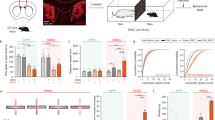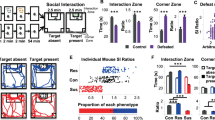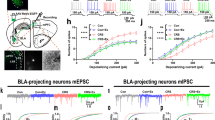Abstract
Anxiety is a normal and transitory emotional state that allows the organisms to cope well with the real or perceived threats, while excessive or prolonged anxiety is a key characteristic of anxiety disorders. We have recently revealed that prolonged anxiety induced by chronic stress is associated with the circuit-varying dysfunction of basolateral amygdala projection neurons (BLA PNs). However, it is not yet known whether similar mechanisms also emerge for acute stress-induced, short-lasting increase of anxiety. Here, using a mouse model of acute restraint stress (ARS), we found that ARS mice showed increased anxiety-like behavior at 2 h but not 24 h after stress, and this effect was accompanied by a transient increase of the activity of BLA PNs. Specifically, ex vivo patch-clamp recordings revealed that the increased BLA neuronal activity did not differ among the distinct BLA neuronal populations, regardless of their projection targets being the dorsomedial prefrontal cortex (dmPFC) or elsewhere. We further demonstrated that such effects were mainly mediated by the enhanced presynaptic glutamate release in dmPFC-to-BLA synapses but not lateral amygdala-to-BLA ones. Furthermore, while optogenetically weakening the presynaptic glutamate release in dmPFC-to-BLA synapses ameliorated ARS-induced anxiety-like behavior, strengthening the release increased in unstressed mice. Together, these findings suggest that acute stress causes short-lasting increase in anxiety-like behavior by facilitating synaptic transmission from the prefrontal cortex to the amygdala in a circuit-independent fashion.
Similar content being viewed by others
Log in or create a free account to read this content
Gain free access to this article, as well as selected content from this journal and more on nature.com
or
References
Raymond JG, Steele JD, Series P. Modeling trait anxiety: from computational processes to personality. Front Psychiatry. 2017;8:1.
Shin LM, Liberzon I. The neurocircuitry of fear, stress, and anxiety disorders. Neuropsychopharmacology. 2010;35:169–91.
Hariri AR, Holmes A. Finding translation in stress research. Nat Neurosci. 2015;18:1347–52.
Katie AM, Laura DK, Erin CD, Robert W, George V, Karestan CK. Childhood social environment, emotional reactivity to stress, and mood and anxiety disorders across the life course. Depress Anxiety. 2010;27:1087–94.
MacNeil G, Sela Y, Mclntosh J, Zacharko RM. Anxiogenic behavior in the light–dark paradigm following intraventricular administration of cholecystokinin-8S, restraint stress, or uncontrollable footshock in the CD-1 Mouse. Pharmacol Biochem Behav. 1997;58:737–46.
McEwen BS. Brain on stress: how the social environment gets under the skin. Proc Natl Acad Sci USA 2012;109:17180–5.
Arnsten FT. Stress weakens prefrontal networks: molecular insults to higher cognition. Nat Neurosci. 2015;18:1376–85.
Jovanovic T, Ressler KJ. How the neurocircuitry and genetics of fear inhibition may inform our understanding of PTSD. Am J Psychiat. 2010;167:648–62.
Di S, Itoga CA, Fisher MO, Solomonow J, Roltsch EA, Gilpin NW, et al. Acute stress suppresses synaptic inhibition and increases anxiety via endocannabinoid release in the basolateral amygdala. J Neurosci. 2016;36:8461–70.
Zhang WH, Zhang JY, Holmes A, Pan BX. Amygdala circuit substrates for stress adaptation and adversity. Biol Psychiatry. 2021;89:847–56.
Roozendaal B, McEwen BS, Chattarji S. Stress, memory and the amygdala. Nat Rev Neurosci. 2009;10:423–33.
Kalin NH, Shelton SE, Davidson RJ. The role of the central nucleus of the amygdala in mediating fear and anxiety in the primate. J Neurosci. 2004;24:5506–15.
Tripathi SJ, Chakraborty S, Rao BSS. Remediation of chronic immobilization stress-induced negative affective behaviors and altered metabolism of monoamines in the prefrontal cortex by inactivation of basolateral amygdala. Neurochem Int. 2020;141:104858.
Beyeler A, Namburi P, Glober GF, Simonnet C, Calhoon GG, Conyers GF, et al. Divergent routing of positive and negative information from the amygdala during memory retrieval. Neuron. 2016;90:348–61.
Felix-Ortiz AC, Burgos-Robles A, Bhagat ND, Leppla CA, Tye KM. Bidirectional modulation of anxiety-related and social behaviors by amygdala projections to the medial prefrontal cortex. Neuroscience. 2016;321:197–209.
Felix-Ortiz AC, Beyeler A, Seo C, Leppla CA, Wildes CP, Tye KM. BLA to vHPC inputs modulate anxiety-related behaviors. Neuron. 2013;79:658–64.
Liu WZ, Zhang WH, Zheng ZH, Zou JX, Liu XX, Huang SH, et al. Identification of a prefrontal cortex-to-amygdala pathway for chronic stress-induced anxiety. Nat Commun. 2020;11:2221.
Zhang WH, Liu WZ, He Y, You WJ, Zhang JY, Xu H, et al. Chronic stress causes projection-specific adaptation of amygdala neurons via small-conductance calcium-activated potassium channel downregulation. Biol Psychiatry. 2019;85:812–28.
Pribiag H, Shin S, Wang EH, Sun F, Datta P, Okamoto A, et al. Ventral pallidum DRD3 potentiates a pallido-habenular circuit driving accumbal dopamine release and cocaine seeking. Neuron. 2021;109:2165–82.
Huang SH, Liu WZ, Qin X, Guo CY, Xiong QC, Wang Y, et al. Association of increased amygdala activity with stress-induced anxiety but not social avoidance behavior in mice. Neurosci Bull. 2022;38:16–28.
Pan HQ, Zhang WH, Liao CZ, He Y, Xiao ZM, Qin X, et al. Chronic stress oppositely regulates tonic inhibition in thy1-expressing and non-expressing neurons in amygdala. Front Neurosci. 2020;14:299–313.
Fang X, Jiang S, Wang J, Bai Y, Kim CS, Blake D, et al. Chronic unpredictable stress induces depression-related behaviors by suppressing AgRP neuron activity. Mol Psychiatry. 2021;26:2299–316.
Cynthia MC, Rosenkranz JA, Anthony AG. Chronic cold stress alters prefrontal cortical modulation of amygdala neuronal activity in rats. Biol Psychiatry. 2005;58:382–91.
Tan T, Wang W, Liu T, Zhong P, Conrow-Graham M, Tian X, et al. Neural circuits and activity dynamics underlying sex-specific effects of chronic social isolation stress. Cell Rep. 2021;34:108874–91.
Zhang JY, Liu TH, He Y, Pan HQ, Zhang WH, Yin XP, et al. Chronic stress remodels synapses in an amygdala circuit-specific manner. Biol Psychiatry. 2019;85:189–201.
O’Leary TP, Sullivan KE, Wang L, Clements J, Lemire AL, Cembrowski MS. Extensive and spatially variable within-cell-type heterogeneity across the basolateral amygdala. Elife. 2020;9:59003–30.
Tovote P, Fadok JP, Luthi A. Neuronal circuits for fear and anxiety. Nat Rev Neurosc. 2015;16:317–31.
Bittar TP, Pelaez MC, Hernandez Silva JC, Quessy F, Lavigne AA, Morency D, et al. Chronic stress induces sex-specific functional and morphological alterations in corticoaccumbal and corticotegmental pathways. Biol Psychiatry. 2021;90:194–205.
Robinson OJ, Krimsky M, Lieberman L, Phillip A, Katherine V, Grillon C. The dorsal medial prefrontal (anterior cingulate) cortex–amygdala aversive amplification circuit in unmedicated generalised and social anxiety disorders: an observational study. Lancet Psychiatry. 2014;1:294–302.
McGarry LM, Carter AG. Prefrontal cortex drives distinct projection neurons in the basolateral amygdala. Cell Rep. 2017;21:1426–33.
McGinnis MM, Parrish BC, Chappell AM, Alexander NJ, McCool BA. Chronic ethanol differentially modulates glutamate release from dorsal and ventral prefrontal cortical inputs onto rat basolateral amygdala principal neurons. eNeuro. 2020;7:0132–19. https://doi.org/10.1523/ENEURO.0132-19.2019.
Cho JH, Deisseroth K, Bolshakov VY. Synaptic encoding of fear extinction in mPFC-amygdala circuits. Neuron. 2013;80:1491–507.
Zhou TT, Zhu H, Fan ZX, Wang F, Chen Y, Liang HX, et al. History of winning remodels thalamo-PFC circuit toreinforce social dominance. Science. 2017;357:162–8.
Qin X, He Y, Wang N, Zou JX, Zhang YM, Cao JL, et al. Moderate maternal separation mitigates the altered synaptic transmission and neuronal activation in amygdala by chronic stress in adult mice. Mol Brain. 2019;12:111–23.
Rosenkranz JA, Venheim ER, Padival M. Chronic stress causes amygdala hyperexcitability in rodents. Biol Psychiatry. 2010;67:1128–36.
Rau AR, Chappell AM, Butler TR, Ariwodola OJ, Weiner JL. Increased basolateral amygdala pyramidal cell excitability may contribute to the anxiogenic phenotype induced by chronic early-life stress. J Neurosci. 2015;35:9730–40.
Yun SH, Reynolds RP, Petrof I, White A, Rivera PD, Segev A, et al. Stimulation of entorhinal cortex–dentate gyrus circuitry is antidepressive. Nat Med. 2018;24:658–66.
Solomonow J, Tasker JG. Anxiety behavior induced in mice by acute stress. Tula Undergrad Res J. 2015;2:14–9.
Robinson SJ, Sunram-Lea SI, Leach J, Owen-Lynch PJ. The effects of exposure to an acute naturalistic stressor on working memory, state anxiety and salivary cortisol concentrations. Stress. 2008;11:115–24.
Jene T, Gassen NC, Opitz V, Endres K, Muller MB, van der Kooij MA. Temporal profiling of an acute stress-induced behavioral phenotype in mice and role of hippocampal DRR1. Psychoneuroendocrinology. 2018;91:149–58.
Marcus DJ, Bedse G, Gaulden AD, Ryan JD, Kondev V, Winters ND, et al. Endocannabinoid signaling collapse mediates stress-induced amygdalo-cortical strengthening. Neuron. 2020;105:1062–76.
Mitra R, Jadhav S, McEwen BS, Vyas A, Chattarji S. Stress duration modulates the spatiotemporal patterns of spine formation in the basolateral amygdala. Proc Natl Acad Sci USA 2005;102:9371–6.
Gupta K, Chattarji S. Sex differences in the delayed impact of acute stress on the amygdala. Neurobiol Stress. 2021;14:100292.
Chakraborty P, Chattarji S. Interventions after acute stress prevent its delayed effects on the amygdala. Neurobiol Stress. 2019;10:100168.
You WJ, He Y, Liu WZ, Zhu YG, Hu P, Pan BX, et al. Exposure to single prolonged stress fails to induce anxiety-like behavior in mice. Stress Brain. 2021;1:145.
Han F, Ding JL, Shi YX. Expression of amygdala mineralocorticoid receptor and glucocorticoid receptor in the single-prolonged stress rats. BMC Neurosci. 2014;15:77–88.
Zheng ZH, Tu JL, Li XH, Hua Q, Liu WZ, Liu Y, et al. Neuroinflammation induces anxiety- and depressive-like behavior by modulating neuronal plasticity in the basolateral amygdala. Brain Behav Immun. 2021;91:505–18.
Yu W, Wang L, Yang L, Li YJ, Wang M, Qiu C, et al. Activation of LXRbeta signaling in the amygdala confers anxiolytic effects through rebalancing excitatory and inhibitory neurotransmission upon acute stress. Neurotherapeutics. 2020;17:1253–70.
Song C, Zhang WH, Wang XH, Zhang JY, Tian XL, Yin XP, et al. Acute stress enhances the glutamatergic transmission onto basoamygdala neurons embedded in distinct microcircuits. Mol Brain. 2017;10:3–13.
Qin X, Liu XX, Wang Y, Wang D, Song Y, Zou JX, et al. Early life stress induces anxiety-like behavior during adulthood through dysregulation of neuronal plasticity in the basolateral amygdala. Life Sci. 2021;285:119959–68.
Kim MJ, Whalen PJ. The structural integrity of an amygdala-prefrontal pathway predicts trait anxiety. J Neurosci. 2009;29:11614–8.
Funding
This work was supported by grants from National Natural Science Foundation of China (Grant Nos. 81930032 and 82125010 to BP, 32222034 and 31970953 to WZ, 82101589 to WL, 32160193 to HP), National Key R&D Program of China (2021ZD0202704 to BP), Natural Science Foundation of Jiangxi Province (20212ACB206038 to WZ, 20192ACB20023 to BP), and China Postdoctoral Science Foundation (Grant Nos. 2021TQ0138 and 2021M701545 to WL). Interdisciplinary Innovation Fund of Natural Science, Nanchang University (9167-27060003-ZD2102 to WZ).
Author information
Authors and Affiliations
Contributions
WZ, WL, and BP conceived the study. WL, SH, YW, CW, HP, and KZ performed the experiments. WL, YW, and PH analyzed the data. WZ and WL wrote the manuscript.
Corresponding authors
Ethics declarations
Competing interests
The authors declare no competing interests.
Additional information
Publisher’s note Springer Nature remains neutral with regard to jurisdictional claims in published maps and institutional affiliations.
Supplementary information
Rights and permissions
Springer Nature or its licensor (e.g. a society or other partner) holds exclusive rights to this article under a publishing agreement with the author(s) or other rightsholder(s); author self-archiving of the accepted manuscript version of this article is solely governed by the terms of such publishing agreement and applicable law.
About this article
Cite this article
Liu, WZ., Huang, SH., Wang, Y. et al. Medial prefrontal cortex input to basolateral amygdala controls acute stress-induced short-term anxiety-like behavior in mice. Neuropsychopharmacol. 48, 734–744 (2023). https://doi.org/10.1038/s41386-022-01515-x
Received:
Revised:
Accepted:
Published:
Issue date:
DOI: https://doi.org/10.1038/s41386-022-01515-x
This article is cited by
-
Acute stress causes sex-specific changes to ventral subiculum synapses, circuitry, and anxiety-like behavior
Nature Communications (2025)
-
Unveiling the enigma of anxiety disorders and depression: from pathogenesis to treatment
Science China Life Sciences (2025)
-
Circuit- and laminar-specific regulation of medial prefrontal neurons by chronic stress
Cell & Bioscience (2023)



